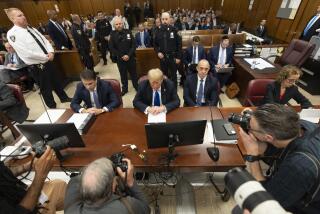Weeding Out of Simpson Jurors Begins : Trial: Two alternates are allowed to leave. Then a lengthy conference between judge and lawyers brings process to a halt.
- Share via
Closing in on the end of a process that began more than two months ago, the judge and lawyers in the O.J. Simpson murder trial completed their questioning of alternate juror candidates Wednesday and began weeding out the group of panelists who have come this far.
Two prospective alternate jurors were allowed to leave, and then Superior Court Judge Lance A. Ito huddled with the attorneys in a long, private conference. After conferring for more than an hour, Ito told most of the 54 remaining jurors and alternate jury candidates that they could go home for the day and return this morning.
“The issues that have come up, and I have to deal with, are relatively complex,” Ito said. “I anticipate that I will spend the rest of the afternoon dealing with them.”
Ito did not specify what the issues were, but a source close to the case said they were related to allegations that at least one member of the jury panel may have been guilty of misconduct--a broad charge that can include anything from improper contact with attorneys to inadvertent exposure to publicity involving the case.
Although Ito closed his courtroom for the hearing and excused most of the panel for the day, he did ask five panelists to remain. The five included three members of the jury itself and two prospective alternates.
By the end of the day, both of those potential alternates were excused as well, emerging from the secretive hearing with little comment on what had transpired. That left a pool of 40 under consideration for possible service.
The unanticipated hearing ground the process to a halt, as surprise developments have done time and again since jury selection began Sept. 26. Because of the latest glitch, the two sides failed to settle on a dozen alternate jurors who will be called into action if any of the panel’s original 12 members are excused between now and the end of the trial, in which the football Hall of Famer is charged with killing Nicole Brown Simpson and Ronald Lyle Goldman. Simpson has pleaded not guilty.
Ito and the attorneys will return to court this morning in the hope of concluding jury selection, which Ito has called the most difficult and delicate task confronting him as he oversees the trial.
If they can finish that this morning, the judge and lawyers will move to consideration of several legal issues, one of which could alter the composition of the jury panel almost as soon as it is seated. Ito has scheduled a hearing for today to consider possible juror misconduct, apparently a continuation of the session that he began Wednesday afternoon.
Deputy Dist. Atty. Marcia Clark said in court earlier this week that “we may be losing someone from our panel of 12.”
Although both sides have long feared that some panelists would be lost by the time the case is over, few had expected the attrition to begin so soon.
Even before the two sides could begin exercising their peremptory challenges for alternate jury candidates Wednesday, several panelists asked to be excused. One prospective alternate announced that she had written to the judge to explain why she should not remain on the case.
That woman, a 53-year-old telephone company employee from Compton, was one of the five panelists asked to stay after the rest of the group had been allowed to go home for the day. She ultimately was excused, declining to comment in detail as she left.
“It’s stressful to me,” the woman said. “This is for someone who doesn’t have a life. I have a life.”
The woman said in court she recently had been approached by a friend who asked her why Judge Ito agreed to give a televised interview even as he was dismissing potential jurors for being exposed to media coverage of the case.
“He’s probably like my father: ‘Do as I say to do, not as I do,’ ” the juror said she responded. She turned to Ito and added: “Sorry, judge.”
Ito smiled and shrugged, declining to pursue the topic, which has become a source of embarrassment and has subjected him to withering criticism from a number of legal commentators.
Although Wednesday’s hearing did not conclude the jury selection process, it did provide each side with one last opportunity to speak to the jury candidates as a group--all 12 of the original jurors and every potential alternate was in court--and to emphasize particular elements of their cases that they want the jurors to ponder.
Throughout the jury selection process, prosecutors have tried to demonstrate to prospective jurors that circumstantial evidence need not be considered any less reliable than direct, eyewitness testimony. The prosecution case against Simpson is thought to rely heavily on circumstantial evidence such as the results of DNA tests that may link Simpson to the murder scene.
That testing has been under way for months, and at least one batch of tests is now all but complete, according to a Dec. 5 letter from Simpson lawyer Robert L. Shapiro addressed to Clark and Ito. In that letter, Shapiro wrote that PCR tests--one type of DNA analysis--have been completed at a Maryland laboratory and are “virtually complete” at a state Department of Justice laboratory in Berkeley.
Those tests probably will play a large role in the government case, and prosecutors have sought to impress upon jurors that circumstantial evidence from such results is in many ways just as reliable as eyewitness testimony.
To make that point, Deputy Dist. Atty. William Hodgman has occasionally employed a simple demonstration: On numerous occasions, he asked prospective jurors to watch as he held up a pen and then dropped it.
Although the jury candidates could not see the pen hit the floor from where they sat, Hodgman noted that they could use their knowledge about the laws of gravity to conclude that the pen logically fell to the floor.
Wednesday, however, Shapiro tried to subvert Hodgman’s example by mimicking the demonstration. After dropping his own pen, Shapiro asked the jury candidates where it had landed. Several responded that it had hit the floor.
But Shapiro reached down and emerged with a box, showing the members of the panel that the pen actually had landed in the container, not on the floor. Their misimpression, Shapiro said, illustrated the perils of relying on circumstantial evidence.
Prosecutor Clark dismissed Shapiro’s demonstration as “this little trick” and accused Shapiro of trying to deceive the jury candidates. She also urged jurors to dismiss anything they have heard about the wildly speculative accounts of the murders that have dominated tabloid--and some mainstream--news coverage of the case.
When the attorneys reconvene in Ito’s courtroom today, they hope to at last finish jury selection, a milestone that will allow the case to proceed to the next stage. Hearings on a jail visitation issue, as well as on the defense’s objection to one prosecutor and on the jury misconduct issues, are set for today but could be delayed until Friday if they cannot settle on an alternate jury panel by lunchtime.
The two sides are trying to complete jury selection and discussion of those issues by week’s end so that they can begin hearings next week on one of the case’s most volatile topics. Defense attorneys have said Simpson never hit his wife and are objecting to the use of any evidence of “marital discord” by prosecutors trying to show that Simpson committed the June 12 murders.
Prosecutors hope to submit at least some evidence of the relationship between the two.
In 1985, police went to Simpson’s home, where they found him in the driveway and Nicole Simpson crying that he had shattered the window of her car. Four years later, Simpson pleaded no contest to charges of spousal battery, and in 1993, police were summoned to Nicole Simpson’s home when she called for help as a man she identified as her ex-husband was trying to force his way into her house.
* IMAGE AND REALITY
Jury misconduct often is just human nature, according to The Spin. B12
More to Read
Sign up for Essential California
The most important California stories and recommendations in your inbox every morning.
You may occasionally receive promotional content from the Los Angeles Times.














